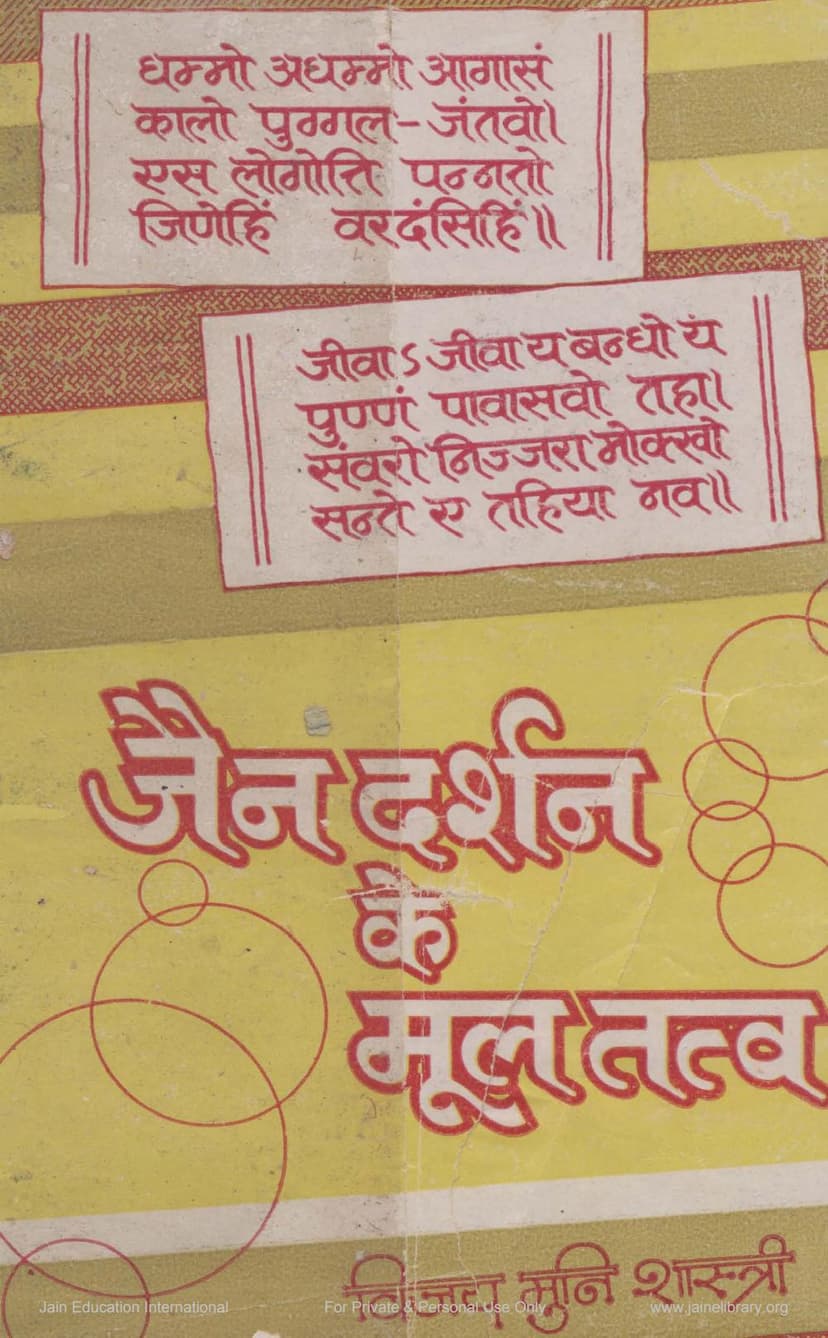Jain Darshan Ke Mul Tattva
Added to library: September 1, 2025

Summary
Here's a comprehensive summary of the Jain text "Jain Darshan ke Mul Tattva" by Vijaymuni Shastri, based on the provided pages:
The book, "Jain Darshan ke Mul Tattva" (Fundamental Principles of Jain Philosophy), authored by Vijaymuni Shastri and published by Diwakar Prakashan, serves as a foundational text for understanding the core tenets of Jainism. The book is dedicated to mark the completion of the "Varshitap" (a year-long ascetic practice) by Sou. Vimladevi Surana and is financially supported by the Oswal Emporium.
Core Philosophy and Introduction:
The book begins with an editorial emphasizing the paramount importance of truth ("Satya"), declaring it as the essence of existence and the foundation of creation. It highlights that true saints and great souls are those who live by truth and dedicate themselves to its pursuit. Jain philosophy, according to the editorial, defines this pursuit as having two pillars: Tattvadarshan (Metaphysics/Philosophy of Reality) and Achardharma (Ethical Conduct), which are equated with Samyagjnana (Right Knowledge) and Samyagcharitra (Right Conduct) respectively. The principle of "Prathamam Jnanam" (Knowledge First) is stressed, asserting that right conduct is only possible with right knowledge.
The editor praises the author, Vijaymuni Shastri, as a dedicated spiritual seeker whose life embodies detachment and luminosity. He is recognized as a scholar, eloquent speaker, and prolific writer, actively contributing to the dissemination of spiritual knowledge. The book is presented as a culmination of the author's dedicated study and a valuable resource for those seeking to understand the fundamental principles of Jainism.
Structure and Content:
The book is structured to provide a comprehensive understanding of Jain philosophy, primarily focusing on:
-
Six Substances (Shatdravya): The book delves into the nature of the six fundamental substances that constitute the Jain universe. These are:
- Dharma Dravya (Principle of Motion): Explains its role as an auxiliary principle for motion.
- Adharma Dravya (Principle of Rest): Explains its role as an auxiliary principle for rest.
- Akasha Dravya (Space): Describes its all-pervading nature and its function of providing space for all substances.
- Kala Dravya (Time): Discusses its role in the transformation and evolution of substances.
- Pudgala Dravya (Matter/Energy): Details its nature as the only material substance, characterized by form, taste, smell, and touch, and its role in the formation of the physical world.
- Jiva Dravya (Soul/Consciousness): Elaborates on its sentient nature, its characteristics of knowledge, perception, bliss, and its role as the experiencing entity.
-
Nine Principles (Nava Tattva): The book systematically explains the nine principles that are central to understanding the path to liberation in Jainism:
- Jiva Tattva (Soul): The sentient substance.
- Ajiva Tattva (Non-Soul): The insentient substances, comprising Pudgala, Dharma, Adharma, Akasha, and Kala.
- Punya Tattva (Merit): Actions leading to happiness and auspicious results.
- Papa Tattva (Demerit): Actions leading to suffering and inauspicious results.
- Asrava Tattva (Influx): The influx of karmic particles into the soul due to passions and activities.
- Samvara Tattva (Stoppage): The cessation of the influx of new karmic particles through right knowledge, conduct, and asceticism.
- Bandha Tattva (Bondage): The actual binding of karmic particles to the soul.
- Nirjara Tattva (Shedding of Karma): The process of shedding already accumulated karma through ascetic practices.
- Moksha Tattva (Liberation): The state of complete freedom from all karmic bondage, leading to the soul's inherent qualities of infinite knowledge, perception, bliss, and energy.
Key Philosophical Concepts Discussed:
- Nature of Substance (Dravya): The book delves into the concept of substance as that which possesses attributes (Guna) and undergoes modifications (Paryaya) while retaining its fundamental essence. It discusses the European philosophical perspectives on substance, drawing parallels and distinctions with Jain metaphysics.
- Cause and Effect: The influence of causality, particularly in relation to time and the actions of substances, is explored. The book highlights the Jain concept of "Pariṇāmī Nitya" (dynamically eternal) for substances, meaning they are eternal in their essence but undergo continuous change in their modes.
- Jiva and Ajiva: A clear distinction is made between the sentient soul (Jiva) and the non-sentient substances (Ajiva). The book elaborates on the characteristics of each, particularly focusing on the soul's capacity for consciousness and experience, contrasting it with the inert nature of Ajiva.
- Comparison with Other Philosophies: The author engages in comparative analysis, drawing connections and distinctions between Jain principles and those of Western philosophies (like Descartes, Spinoza, Leibniz, Aristotle, Plato, Socrates) and other Indian philosophical schools (like Sankhya, Yoga, Vedanta, Nyaya, Vaisheshika, Bauddha, Charvaka). This comparative approach aims to contextualize Jain thought within a broader intellectual landscape.
- Pudgala and its Transformations: A detailed explanation of matter (Pudgala) is provided, including its subtle and gross forms, its atomic nature (Parmanu), and the various permutations and combinations it undergoes, such as sound, darkness, light, shadow, etc. The relationship between Pudgala and the soul is explored, particularly how karmic matter binds the soul.
- The Path to Liberation: The principles of Samvara, Nirjara, and Moksha are explained as the means to achieve liberation, emphasizing the role of right knowledge, right conduct, and ascetic practices in purifying the soul and breaking free from the cycle of birth and death.
The Role of the Author and the Book:
The book is presented not just as an academic treatise but as a guide for spiritual seekers. The author's profound scholarship and spiritual insights are lauded. The publication is intended to make the profound teachings of Jainism accessible to a wider audience, facilitating a deeper understanding and appreciation of its philosophical depth. The book concludes with an appendix containing a glossary of technical terms, providing clarity for readers.